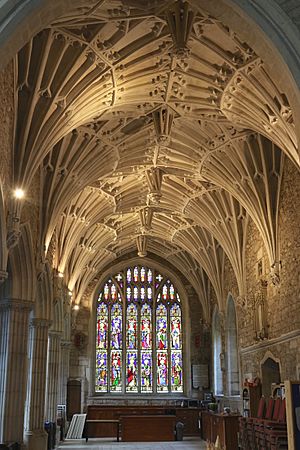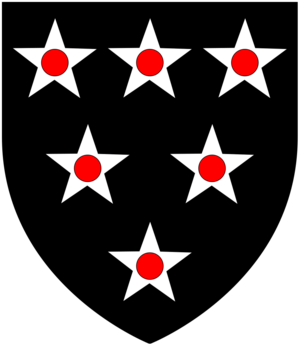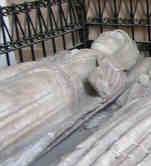Cecily Bonville, 7th Baroness Harington facts for kids
Quick facts for kids
Cecily Bonville
|
|
|---|---|
| suo jure Baroness Harington and Bonville Marchioness of Dorset Countess of Wiltshire |
|

Presumed effigy of Cecily Bonville on her tomb in the Church of St. Mary the Virgin, Astley, Warwickshire, drawing of 1890
|
|
| Born | 30 June 1460 Shute Manor, Shute, near Axminster, Devon, England |
| Died | 12 May 1529 (aged 68) Shacklewell, Hackney, Middlesex |
| Buried | Collegiate Church of St. Mary the Virgin, Astley, Warwickshire |
| Noble family | Bonville Neville |
| Spouse(s) |
|
| Issue |
|
| Father | William Bonville, 6th Baron Harington |
| Mother | Katherine Neville |
Cecily Bonville (born 30 June 1460 – died 12 May 1529) was a very important English noblewoman. She was known as the 7th Baroness Harington and 2nd Baroness Bonville in her own right. This means she inherited these titles directly, not through marriage.
Cecily was also the Marchioness of Dorset through her first marriage to Thomas Grey, 1st Marquess of Dorset. Later, she became the Countess of Wiltshire when she married Henry Stafford, 1st Earl of Wiltshire.
Her family, the Bonvilles, strongly supported the House of York during the Wars of the Roses. These were a series of civil wars fought for the English throne. When Cecily was less than a year old, she became the richest heiress in England. This happened because her male relatives died fighting against the House of Lancaster in these wars.
After her first husband died in 1501, Cecily had a big disagreement with her son, Thomas Grey, 2nd Marquess of Dorset. They argued about her right to manage her late husband's money and her own inheritance. Their quarrel was so serious that King Henry VII and his royal council had to step in.
Cecily Bonville was also the great-grandmother of Lady Jane Grey, Lady Catherine Grey, and Lady Mary Grey. Lady Jane Grey famously reigned as Queen of England for nine days in July 1553.
Contents
Cecily's Early Life and Inheritance
Cecily Bonville was born around 30 June 1460 at Shute Manor in Shute, England. She was the only child of William Bonville, 6th Baron Harington and Lady Katherine Neville. Her mother was the younger sister of Richard Neville, 16th Earl of Warwick, a famous military leader known as "Warwick the Kingmaker."
Cecily's family gained the Barony of Harington when her grandfather, William Bonville, married Elizabeth Harington. Elizabeth was the daughter and heiress of the 5th Baron Harington.
When Cecily was only six months old, her father and grandfather were executed. This happened after the Battle of Wakefield on 30 December 1460. The Bonvilles fought for the Yorkists and were shown no mercy by the victorious Lancastrian troops. Cecily's great-grandfather, William Bonville, 1st Baron Bonville, was also executed soon after.
These tragic events made Cecily Bonville the wealthiest heiress in England. She inherited many estates across the country. She became the 7th Baroness Harington on 30 December 1460 and the 2nd Baroness Bonville on 18 February 1461.
Her Stepfather and Family
Cecily's mother remarried shortly before February 1462. Her new husband was William Hastings, 1st Baron Hastings. He was one of the most powerful men in England at the time. Lord Hastings served as Lord Chamberlain, a high-ranking official, and was a personal advisor to King Edward IV. King Edward IV, who was Cecily's first cousin once removed, had taken the English throne in 1461.
When Cecily's mother married Lord Hastings, he also gained the "wardship" of Cecily. This meant he became her legal guardian and was responsible for her and her inheritance.
Through her mother's marriage, Cecily gained three half-brothers: Edward Hastings, 2nd Baron Hastings, Richard Hastings, and William Hastings. She also had a half-sister, Anne Hastings.
Cecily's First Marriage
Cecily was considered a possible bride for William, the son of the Earl of Pembroke. However, her uncle, the Earl of Warwick, refused the offer around 1468. He felt that Pembroke's son was not noble enough for his family.
About six years later, a husband was found for Cecily. She married Thomas Grey, 1st Marquess of Dorset, on 18 July 1474. She was just over fourteen years old. Thomas was the eldest son of King Edward IV's queen, Elizabeth Woodville, from her first marriage.
This was Thomas's second marriage. His first wife had died without children. Queen Elizabeth Woodville arranged Cecily's marriage to Thomas. She even bought Cecily's wardship from Baron Hastings to make it happen. Cecily's stepfather disliked Thomas, and her mother was against the marriage.
At the time of their marriage, Thomas was the Earl of Huntingdon. He later became the Marquess of Dorset in 1475. Since women were not allowed to sit in Parliament, Thomas represented Cecily's titles as Baron Harington and Bonville.
After King Edward IV died in 1483, Thomas Grey and his mother tried to gain power. However, King Edward's brother, Richard, Duke of Gloucester, became Lord Protector. Richard quickly stopped their plans.
Later, Thomas joined a rebellion against King Richard III, but it failed. Thomas fled to France, leaving Cecily in England. King Richard III made sure Cecily and other rebels' wives were safe and their property was not harmed.
Thomas eventually returned to England and was present at the coronation of Henry Tudor, who became King Henry VII after winning the Battle of Bosworth in 1485. King Henry VII lifted the charges against Thomas. Cecily and Thomas also attended the wedding of King Henry VII and Elizabeth of York in 1486. Elizabeth was Thomas's half-sister.
Cecily was honored at the baptism of Prince Arthur, the King's son. She was chosen to carry the baby's long robe.
Cecily and Thomas had fourteen children together, and eleven of them lived to adulthood. Their eldest son, Thomas, was born in June 1477.
Cecily's Children

was the great-granddaughter of Cecily Bonville and her first husband, Thomas Grey, 1st Marquess of Dorset
- Thomas Grey, 2nd Marquess of Dorset (1477–1530); he had children, including Henry Grey, 1st Duke of Suffolk. Henry was the father of Lady Jane Grey, Lady Catherine Grey, and Lady Mary Grey.
- Leonard Grey, 1st Viscount Grane (c.1478–1541); he was a Lord Deputy of Ireland.
- Dorothy Anne Grey (1480–1552); she married twice and had children.
- Mary Grey (1491–1538); she married Walter Devereux, 1st Viscount Hereford, and had three sons.
- Elizabeth Grey (c.1497–after 1548); she was a Maid of Honour to Queen Mary Tudor.
- Cecily Grey (died 1554); she married John Sutton, 3rd Baron Dudley.
- Edward Grey; he married Anne Jerningham.
- Eleanor Grey; she married John Arundell (1474–1545).
- Margaret Grey; she married Richard Wake.
- Anthony Grey; died young.
- Bridget Grey; died young.
- George Grey; became a clergyman.
- Richard Grey; he married Florence Pudney.
- John Grey; died young.
Later Years and Contributions
The "Dorset Aisle"

In the 1490s, Cecily designed and added a beautiful fan-vaulted north aisle to the Church of Ottery St Mary in Devon. This part of the church is now known as the "Dorset Aisle." Cecily was inspired by the design of St George's Chapel at Windsor Castle, which she had visited.
Her family's coat-of-arms, a figure of St. Cecilia, and other carved symbols are displayed throughout the aisle. These represent her own family and her two husbands' families. She also made additions to other churches in her areas, but the Dorset Aisle was her most detailed and splendid project.
When Thomas Grey died in September 1501, Cecily's eldest son, Thomas, inherited his father's title and some lands. However, Cecily kept most of her late husband's properties.
Dispute with Her Son
Cecily married for a second time in 1503 to Henry Stafford, 1st Earl of Wiltshire. This marriage did not produce any children. Cecily was 43 years old, and Henry Stafford was 19 years younger than her.
Her son, Thomas, the 2nd Marquess of Dorset, strongly disliked this marriage. He worried that Cecily would use her inheritance to support her new husband instead of him. Cecily did give Stafford some land for his lifetime.
This led to a big argument between Cecily and her son. Thomas challenged her right to manage his father's estate. King Henry VII and his council had to step in to settle the dispute. The King decided that Cecily could manage her late husband's estate until his debts were paid. However, she had to give the rest of her son's inheritance to him. The King's decision also limited her control over her own inheritance. She had to leave all of it to Thomas when she died.
Nearly twenty years later, Cecily and her son argued again. This time, it was about their duties to Thomas's seven surviving brothers and sisters. Cardinal Thomas Wolsey helped settle this dispute. He ordered both Cecily and Thomas to contribute to the dowries (money or property brought by a bride to her marriage) of her four living daughters. She also had to give regular payments from her own money to her three younger sons.
In 1527, Cecily gave her daughter Elizabeth an extra dowry of £1000. This was for Elizabeth's marriage to the Earl of Kildare, even though Cecily and her first husband had not wanted that marriage. Cecily explained that the marriage was "honourable" and that she and her friends were now happy with it.
Cecily made her last will on 6 March 1528. She signed it as "Cecill Marquess of Dorset, Lady Haryngton and Bonvyll, late wife of Thomas Marquess of Dorset."
Death and Legacy
During her lifetime, Cecily transformed Shute Manor from a medieval house into a grand Tudor home. She spent her final years at Astley Castle in Astley, Warwickshire, which was the Grey family's main residence.
Cecily died on 12 May 1529 in Shacklewell, London, during an outbreak of the sweating sickness. She was almost 69 years old. Her second husband had died six years earlier, deep in debt, which Cecily was legally required to repay.
She was buried in the Collegiate Church of St. Mary the Virgin, Astley, Warwickshire. Her stone statue, or effigy, can still be seen there. It shows her wearing a special head-dress and long robes, with two small dogs at her feet. In her will, Cecily had asked to be buried with her first husband and for a "goodly tomb" to be built. She also requested a thousand masses to be said for her soul.
Cecily Bonville had many famous descendants. These include Lady Jane Grey, Lady Catherine Grey, Elizabeth FitzGerald, Countess of Lincoln, and Robert Devereux, 2nd Earl of Essex.
In Fiction
Cecily Bonville is the main character in The Summer Queen, a historical romance novel. It was written by Alice Walworth Graham and published in 1973. This novel is mostly fictional and takes many liberties with the known facts of Cecily's life. It should not be considered a true biography.



